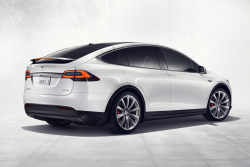— A Tesla Model X crash has caused the insurance company for the Tesla driver to sue the automaker by claiming the crash occurred with the Autopilot feature activated.
Insurance provider MemberSelect says it provided auto insurance for the driver of the Model X, David Gillie, but because of failures of the Autopilot system, the company made a payment to Mr. Gillie for the significant damage caused to the Model X in the amount of $112,445.54, including the deductible.
The insurance company says that despite its suggestive name and marketing campaign, "Tesla produced a semi-autonomous vehicle that misleadingly appeared to be fully autonomous."
According to court documents, Gillie was driving his Model X with his wife along Interstate 94 in Wisconsin with the Autopilot system engaged. The plaintiff claims the SUV suddenly veered left across the highway lane markers into a construction zone, causing the Model X to collide with a construction barricade.
Gillie says he tried to steer the Model X to the right to counter the sudden move to the left but couldn't prevent the crash. According to the lawsuit, Mrs. Gillie sustained "significant personal injuries" caused by the crash.
Gillie says he purchased a 2016 Tesla Model X 90D in 2016 with an optional "Tech Package" at an additional cost which enabled the use of Autopilot.
The plaintiff says Autopilot advertised to include multiple subsystems such as Autosteer, Auto Lane Change, Automatic Emergency Braking, Traffic-Aware Cruise Control, Side Collision Warning and Autopark.
In addition, the lawsuit claims Tesla advertised the package as providing a way to “automatically steer down the highway, change lanes, and adjust speed in response to traffic," all without requiring the driver to touch the steering wheel.
The lawsuit alleges less than one week after the September 2016 crash, Tesla released its Autopilot 8.0 software update that changed the functionality of the Autopilot system by modifying driver monitoring and adding several new driver assistance safety features unavailable in Autopilot 7.0.
The plaintiff claims Autopilot 7.0 relied primarily on the front-facing camera to detect obstacles, but Autopilot 8.0 allegedly uses onboard radar as the primary source for Autopilot which allows the SUV to “see” through rain, fog, snow or dust.
Using radar as the primary sensor instead of camera imaging allegedly prevents situations where, in the past, the vehicle would not react to an obstacle that was picked up by radar but not the camera.
The lawsuit also alleges Autopilot 8.0 substantially "increased the frequency and blatancy of warnings posed to drivers who remove their hands from the steering wheel, ultimately forcing the driver to restart the vehicle if repeated warnings are ignored."
The plaintiff says the risks and dangers of the Model X and the Autopilot feature "significantly outweighed any benefits of such design."
According to the lawsuit, Tesla failed to provide adequate warnings about potential failures of Autopilot systems that allowed the Model X to fail to detect highway lane markers. The plaintiff also argues Tesla failed to design its automatic emergency braking system in such a way that would "provide any warning or automated braking for the collision event."
The Tesla lawsuit was filed in the Circuit Court of the Nineteenth Judicial Circuit, Lake County Illinois - MemberSelect Insurance Company and David Gillie v. Tesla, Inc.
The plaintiff is represented by Leahy, Eisenberg & Fraenkel.

